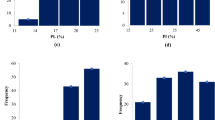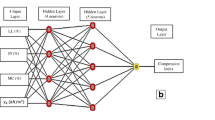Abstract
The present research aims to enhance the stability of soil by utilizing varying dosages of cement and lime. Additionally, the study seeks to create a predictive model based on Artificial Neural Network to estimate the unconfined compressive strength (UCS). During the investigation, the materials under examination underwent essential engineering tests, including microstructural characterization and the UCS test. The results from the UCS test indicated a consistent increase in strength values as the curing time and cement content were raised. To develop the predictive model for UCS, ANN-based models with sigmoid function with different architectures were constructed. A multiple regression model was also used for comparison. The training dataset comprised 80 data points, while the testing dataset contained 20 data points. The data set was divided into 3 parts: training, testing and validation. From data set, 60% data were used for training, and 10 and 30% were used for validation and testing, respectively. The outcomes of the study demonstrated that the ANN model 4 (8-16-32-1) utilizing the feed forward Levenberg–Marquardt (trainlm) backpropagation function outperformed all other models, achieving an R value of 0.89 during training and 0.7 during testing. In summary, this research focuses on stabilizing soil by employing cement and lime, while also develo** an effective ANN-based model to predict the unconfined compressive strength of soil. The study showcases the superiority of the ANN model with the feedforward Levenberg–Marquardt (trainlm) backpropagation function and underscores the significant influence of cement content on the UCS prediction.
















Similar content being viewed by others
Data availability
The dataset generated during and/or analysed during the current study are available from the corresponding author on reasonable request.
References
Benali, A., Nechnech, A., & Ammar, B. D. (2013). Principal component analysis and Neural Networks for predicting the pile capacity using SPT. International Journal of Engineering and Technology, 5(1), 87–99.
Edil, T. B., Acosta, H. A., & Benson, C. H. (2006). Stabilizing softfne-grained soils with fy ash. Journal of Materials in Civil Engineering, 18(2), 283–294. https://doi.org/10.1061/(ASCE)0899-1561(2006)18:2(283)
IS 12269. (1987). 53 grade ordinary Portland cement. New Delhi: Bureau of Indian Standard.
Kashyap, V., Poddar, A., Sihag, P., et al. (2023). Forecasting compressive strength of jute fiber reinforced concrete using ANFIS, ANN, RF and RT models. Asian Journal of Civil Engineering. https://doi.org/10.1007/s42107-023-00892-y
Kaveh, A. & Khavaninzadeh, N. (2023). Efcient training of two ANNs using four meta-heuristic algorithms for predicting the FRP strength. In Structures (Vol. 52, pp. 256–272). Elsevier: Amsterdam. https://doi.org/10.1016/j.istruc.2023.03.178.
Kaveh, A., Bakhshpoori, T., & Hamze-Ziabari, S. M. (2018). GMDH-based prediction of shear strength of FRP-RC beams with and without stirrups. Computers and Concrete, an International Journal, 22(2), 197–207.
Kaveh, A., Elmieh, R., & Servati, H. (2001). Prediction of momentrotation characteristic for semi-rigid connections using BP neural networks. Asian Journal of Civil Engineering, 2(2), 131–142.
Kaveh, A., & Iranmanesh, A. (1998). Comparative study of backpropagation and improved counterpropagation neural nets in structural analysis and optimization. International Journal of Space Structures, 13(4), 177–185. https://doi.org/10.1177/026635119801300401
Khan, R. A., Khan, A. R., Verma, S., & Islam, S. (2016). California bearing ratio analysis for RDFS in unsoaked condition. International Journal for Research in Technological Studies, 3(3), 2348–1439.
Kolay P. K., Rosmina A. B., & Ling, N. W. (2008). Settlement prediction of tropical soft soil by Artificial Neural Network (ANN). In The 12th International Conference of International Association for Computer Methods and Advances in Geomechanics (IACMAG), pp. 1843–1848.
Kolias, S., Kasselouri-Rigopoulou, V., & Karahalios, A. (2005). Stabilisation of clayey soils with high calcium fy ash and cement. Cement and Concrete Composites, 27(2), 301–313. https://doi.org/10.1016/j.cemconcomp.2004.02.019
Kumar, A., & Sinha, S. (2023a). Multiwalled Carbon nanotube aided fy ash-based subgrade soil stabilization for low-volume rural roads. International Journal of Geosynthetics and Ground Engineering, 9(2), 17. https://doi.org/10.1007/s40891-023-00436-z
Kumar, A., & Sinha, S. (2023b). Role of multiwalled carbon nanotube in the improvement of compaction and strength characteristics of fy ash stabilized soil. International Journal of Pavement Research and Technology. https://doi.org/10.1007/s42947-023-00274-2
Kumar, A., Sinha, S., Saurav, S., et al. (2023). Prediction of unconfined compressive strength of cement–fly ash stabilized soil using support vector machines. Asian Journal of Civil Engineering. https://doi.org/10.1007/s42107-023-00833-9
Le, H. A., Nguyen, T. A., Nguyen, D. D., & Prakash, I. (2020). Prediction of soil unconfned compressive strength using Artifcial Neural Network Model. Vietnam Journal of Earth Sciences. https://doi.org/10.15625/0866-7187/42/3/15342
Mackiewicz, S. M. & Ferguson, E. G. (2005). Stabilization of soil with self-cementing coal ashes. In World of Coal Ash (WOCA), pp. 1–7.
Mohsen, S., Cedrick, K.K., Nataraj, C. (2013). Diagnostic of a nonlinear pendulum using computational intelligence. In Proceedings of the ASME dynamic systems and control conference, Palo Alto, California, USA.
Ngo, H. T. T., Pham, T. A., Vu, H. L. T., & Giap, L. V. (2021). Application of artifcial intelligence to determined unconfned compressive strength of cement-stabilized soil in vietnam. Applied Sciences, 11(4), 1949. https://doi.org/10.3390/app11041949
Onyelowe, K. C., Ebid, A. M., & Hanandeh, S. (2023). Advanced machine learning prediction of the unconfined compressive strength of geopolymer cement reconstituted granular sand for road and liner construction applications. Asian Journal of Civil Engineering. https://doi.org/10.1007/s42107-023-00829-5
Rabbani, A., Samui, P., & Kumari, S. (2023). Implementing ensemble learning models for the prediction of shear strength of soil. Asian Journal of Civil Engineering, 24, 2103–2119. https://doi.org/10.1007/s42107-023-00629-x
Salahudeen, A. B., Ijimdiya, T. S., Eberemu, A. O., & Osinubi, K. J. (2018). Artificial neural networks prediction of compaction characteristics of black cotton soil stabilized with cement kiln dust. Journal of Soft Computing in Civil Engineering, 2(3), 53–74.
Shahin, M. A., Maier, H. R., & Jaksa, M. B. (2002). Predicting settlement of shallow foundations using Neural Networks. Journalof Geotechnical and Geoenvironmental Engineering, ASCE, 128(9), 785–793.
Suthar, M. (2020). Applying several machine learning approaches for prediction of unconfned compressive strength of stabilized pond ashes. Neural Computing and Applications, 32(13), 9019–9028. https://doi.org/10.1007/s00521-019-04411-6
Tastan, E. O., Edil, T. B., Benson, C. H., & Aydilek, A. H. (2011). Stabilization of organic soils with fy ash. Journal of Geotechnical and Geoenvironmental Engineering, 137(9), 819–833. https://doi.org/10.1061/(ASCE)GT.1943-5606.0000502
Tran, V. Q. (2022). Hybrid gradient boosting with meta-heuristic algorithms prediction of unconfned compressive strength of stabilized soil based on initial soil properties, mix design and efective compaction. Journal of Cleaner Production, 355, 131683. https://doi.org/10.1016/j.jclepro.2022.131683
Funding
The authors have not disclosed any funding.
Author information
Authors and Affiliations
Contributions
AK: conceptualization, methodology, investigation. VS: data curation, writing—original draft. SS: Software. RK: conceptualization methodology supervision, visualization, resources, writing—review & editing. SB: review & editing.
Corresponding author
Ethics declarations
Competing interests
The authors declare no competing interests.
Additional information
Publisher's Note
Springer Nature remains neutral with regard to jurisdictional claims in published maps and institutional affiliations.
Rights and permissions
Springer Nature or its licensor (e.g. a society or other partner) holds exclusive rights to this article under a publishing agreement with the author(s) or other rightsholder(s); author self-archiving of the accepted manuscript version of this article is solely governed by the terms of such publishing agreement and applicable law.
About this article
Cite this article
Kumar, A., Singh, V., Singh, S. et al. Prediction of unconfined compressive strength of cement–lime stabilized soil using artificial neural network. Asian J Civ Eng 25, 2229–2246 (2024). https://doi.org/10.1007/s42107-023-00905-w
Received:
Accepted:
Published:
Issue Date:
DOI: https://doi.org/10.1007/s42107-023-00905-w




